Table of Contents
Out with Pangolins, in with Raccoon Dogs!
On November 18, 2021, a paper published in the journal Science titled “Dissecting the early COVID-19 cases in Wuhan” purported to revise the timeline of the earliest known COVID‑19 cases. Whereas it had previously been reported that the first known case was a man named Mr. Chen who had no connection to the Huanan Seafood Wholesale Market in Wuhan, China, according to the revised timeline, the first known case was a woman named Ms. Wei, who was a seafood vendor at the market.
The finding that the first known case was a market vendor coupled with the known fact that raccoon dogs were being sold at the market at the time of the COVID‑19 outbreak in late 2019, the author argued, strengthened the case for a natural origin of SARS‑CoV‑2, as opposed to the hypothesis that this coronavirus was genetically engineered in a laboratory.
When that paper was published, the New York Times and other major media outlets ran with the story, including the characterization of the revised timeline as strengthening the hypothesis that the coronavirus had a natural origin, making the leap from bats to humans via an intermediary host species being sold at the market. Specifically, the media echoed the paper’s author by identifying the raccoon dog as the most likely culprit.
Numerous major media outlets, including Fox News, TIME, Reuters, and The Guardian, reported that most of the early symptomatic cases were not just linked to the market but specifically to the western section “where raccoon dogs were caged”.
Thus, the media parroted the claim made by the paper’s author that it was a proven fact that raccoon dogs were being sold at the market at the time of the COVID‑19 outbreak.
Evidently, not one major media outlet could be bothered to check the sources cited in the paper to support that claim. In fact, the scientist’s claim that it was a known fact that raccoon dogs were being sold in the southwest corner of the market at the time of the outbreak was also unsupported by his cited sources.
The paper’s author was also publicly rebuked for his revisionary Science paper by Dr. Liang Wannian, the head of the Chinese side of the WHO-China joint mission to investigate the origins of SARS‑CoV‑2, who maintained that Mr. Chen’s symptom onset date was not December 16, 2020, as claimed in the paper, but December 8, as stated in the WHO’s report that the scientist was purporting to correct. Liang said at a press conference that Mr. Chen “started experiencing flu-like symptoms such as headache and dizziness on December 8, followed by fatigue, muscle pain, and shortness of breath, which were later confirmed to be COVID‑19.”
The name of that scientist is Dr. Michael Worobey, who is a member of the same team of researchers who recently published a paper on the preprint server Zenodo reporting that genetic material from a raccoon dog was found in a sample collected from a transport cart in the southwest corner of the market by researchers from the Chinese Center for Disease Control (CCDC), who only recently uploaded the previously unpublished metagenomic sequencing data from samples to the international genomic database GISAID.
The CCDC researchers have also since published their own preprint paper at ChinaXiv discussing this newly released data. They confirmed that raccoon dog DNA was found in the sample but emphasized that this does not show that any raccoon dogs were infected with SARS‑CoV‑2, much less that an infected animal transmitted the virus to humans and not vice versa.
Before their preprint was published, the advocates of the market origin hypothesis sought the media’s help to propagate their finding and conclusion to the public. The news was first reported by The Atlantic on March 16, 2023, under a headline describing it as “The Strongest Evidence Yet That an Animal Started the Pandemic”.
Conspicuously absent from the mainstream media’s reporting, however, is the alternative perspective that, if this is the strongest evidence yet for the zoonotic origin hypothesis, it just makes the case for a lab origin all that much stronger.
Also conspicuously absent from the media’s coverage is an important backstory: four of Worobey’s coauthors—Kristian G. Andersen, Andrew Rambaut, Edward C. Holmes, and Robert F. Garry—were also authors of the infamous paper titled “The proximal origin of SARS‑CoV‑2”, published in Nature on March 17, 2020.
That is one of two influential early articles that the media continually relied upon to dismiss the lab origin hypothesis as a baseless “conspiracy theory”, as we’ll come back to.
Notably, in the “proximal origin” paper, to bolster their case for a zoonotic origin, Andersen et al. pointed to pangolins as the most likely intermediary species.
Another relevant detail conspicuously absent from the mainstream media’s recent coverage of the subject is how the pangolin hypothesis was subsequently abandoned.
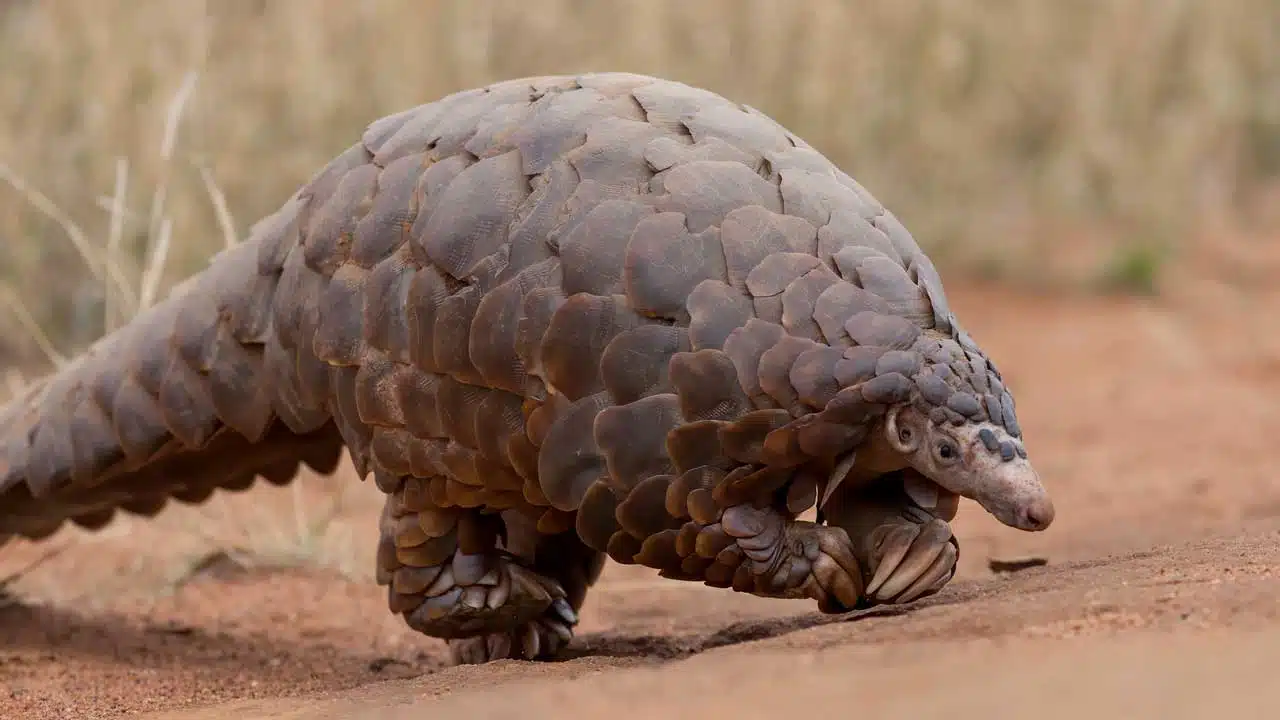
Dr. Worobey was not a coauthor of the “proximal origin” paper, but he subsequently teamed up with those four of its five authors on numerous papers advocating a zoonotic origin for SARS‑CoV‑2.
To support that position, in his paper “Dissecting the early COVID-19 cases in Wuhan”, Worobey made numerous claims that are false or, at best, misleading.
The claim that it was a proven fact that raccoon dogs were being sold in the southwest area of the market in November and December of 2019 was repeated by Worobey and coauthors in several additional papers, but that claim was in every instance unsupported by their cited sources.
Instead, this team of scientists merely created the illusion of their claim having been proven by citing numerous supposedly corroborating sources, including their own prior papers, when in fact there were just three primary sources cited in all those papers, none of which actually provided credible documentary evidence that raccoon dogs were present in the market during the relevant timeframe.
This record of deception is relevant because the same group of scientists have claimed that the DNA evidence of raccoon dogs in the market “corroborates” that earlier claim of theirs.
This is a curious claim since, if it was already a proven fact, there would be no need for corroboration, and the newly published genomic evidence would add absolutely nothing new to the debate.
It is also untrue that the new data corroborates their earlier claim.
As Matt Ridley, coauthor with Dr. Alina Chan of the book Viral: The Search for the Origin of COVID‑19, told The Telegraph, “All this paper proves is that raccoon dogs were in the market, and we already knew that. We just didn’t know they were there at the outbreak, and we still don’t know because that DNA could have been left over from months earlier.” (Emphasis added.)
Michael Imperiale, a virologist at the University of Michigan, similarly told the New York Times that, depending on the stability of genetic material found in the sample from both the raccoon dog and the virus, “they could have been deposited there at potentially widely different times.”(Emphasis added.)
In an email to Worobey requesting comment on the findings of my own investigation into his and his coauthors’ claims, I asked about the possibility that the DNA evidence represented contamination from months earlier and was therefore not inconsistent with the finding reported by the WHO that, while raccoon dogs hadbeen sold at the market in the past, there was no evidence of this occurring at the time of the COVID‑19 outbreak.
Dr. Worobey did not respond to my request for comment.
The Orchestrated Suppression of the Lab-Origin Hypothesis
Since very early into the COVID‑19 pandemic, there has been a concerted effort on the part of interested parties to suppress information about the possible lab origin of SARS‑CoV‑2.
The mainstream media served its typical function by falsely labeling this legitimate scientific hypothesis a baseless “conspiracy theory”. Facebook, in collaboration with its media “fact check” partners, went so far as to prohibit any discussion of a lab origin, a ban that wasn’t lifted until late May 2021.
As mentioned, the Nature article by Andersen et al., who boldly proclaimed that their analyses “clearly show that SARS‑CoV‑2 is not a laboratory construct or a purposefully manipulated virus”, was continually cited by the media to dismiss the possibility of a lab origin.
It was later revealed through Freedom of Information Act (FOIA) requests that, prior to drafting the “proximal origin” paper, the authors had consulted with Dr. Anthony Fauci, the Director of the National Institute of Allergy and Infectious Diseases (NIAID) under the National Institutes of Health (NIH), and Dr. Francis Collins, Director of the NIH.
Also participating in the private correspondences was Jeremy Farrar, director of the Wellcome Trust since 2013. Farrar stepped down from that role on February 25, 2023, to take up the position of Chief Scientist of the WHO.
The authors of the “proximal origin” article were, in the words of lead author Kristian Andersen, “prompted” by Fauci and Collins to draft a paper “trying to disprove any type of lab theory”. Fauci was sent the draft for his review and approval prior to its publication.
On April 17, 2020, at a White House press conference, Fauci, who also served as chief medical advisor to the president, trotted out the paper as though it presented an airtight case in favor of a natural origin. “There was a study recently that we can make available to you,” Fauci said, “where a group of highly qualified evolutionary virologists looked at the sequences there, the sequences in bats as they evolve, and the mutations that it took to get to the point where it is now is totally consistent with a jump of a species from an animal to a human.”
Fauci then pretended as though he hadn’t been involved in the drafting of that paper, even feigning not to know the authors or to remember their names. “So the paper will be available,” he added. “I don’t have the authors right now, but we can make it available to you.”
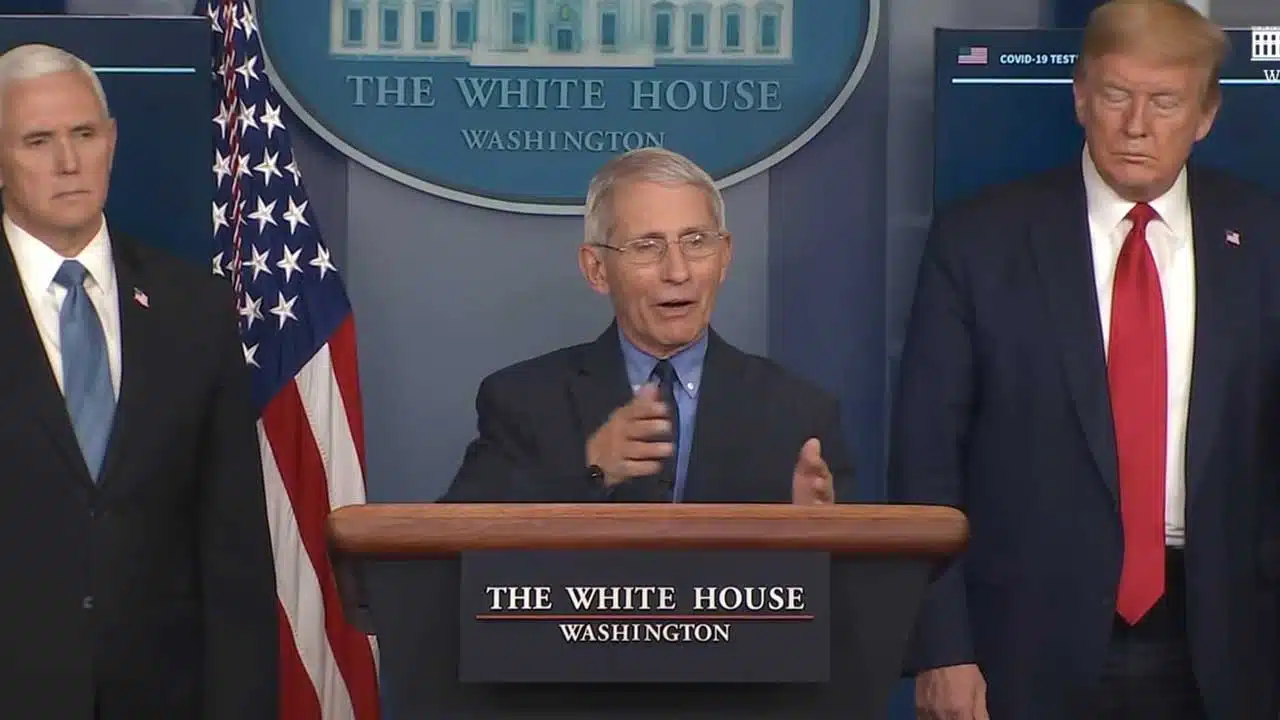
The conclusion arrived at in that paper was a reversal from Andersen’s own first impression after having analyzed the published genome of SARS‑CoV‑2. As later revealed, on January 31, 2020, Andersen sent an email to Fauci noting “unusual features” in the virus that “(potentially) look engineered.”
Referencing Edward Holmes and Robert Garry, who would later become coauthors of the “proximal origins” paper, Andersen added that, “Eddie, Bob, Mike and myself all find the genome inconsistent with expectations from evolutionary theory.”
Andersen’s remark about “unusual features” in the SARS‑CoV‑2 genome was undoubtedly a reference to the furin cleavage site of the SARS‑CoV‑2 spike protein, which is the part of the virus that enables it to bind with human cells expressing the ACE2 receptor and thereby to gain entry through the membrane to infect the cell.
Five months after the publication of the “proximal origin” paper in Nature, the NIH announced an NIAID grant totaling $8.9 million to Andersen’s lab, the ostensible purpose of which was “to improve our understanding of emerging and re-emerging infectious diseases and develop a scalable response network to rapidly address outbreaks.”
Anthony Fauci and Francis Collins had a very clear motive for coordinating with the authors in this effort to quash the lab origin hypothesis. Fauci’s NIAID and its parent agency the NIH had funded the organization EcoHealth Alliance, which in turn funneled money to researchers from the Wuhan Institute of Virology who were conducting “gain of function” experiments with coronaviruses, such as engineering spike proteins from various bat coronaviruses onto the backbone of a SARS-like coronavirus named WIV1 to see if they could get their chimeric virus to infect human cells.
The president of EcoHealth Alliance is Dr. Peter Daszak, who similarly orchestrated an influential letter signed by numerous scientists and published in The Lancet on February 19, 2020, dismissing the lab origin hypothesis as a harmful “conspiracy theory”.
Another notable signatory of that letter was Jeremy Farrar.
A notable omission from the names appearing on the letter is Dr. Ralph Baric, whom Daszak had advised not to sign the letter to prevent its self-serving nature from becoming all the more transparent.
In signing his own name to the letter, Daszak lied that he had no conflicts of interest.
Baric is known for having collaborated with Daszak and researchers from the Wuhan Institute of Virology on experiments involving genetic manipulation of coronaviruses, including so-called “gain-of-function” experiments.
For example, Baric was the senior author of a controversial paper published in Nature Medicine in November 2015 titled “A SARS-like cluster of circulating bat coronaviruses shows potential for human emergence”. Among his coauthors was “bat woman” Shi Zhengli, the most well-known researcher from the Wuhan lab.
That paper described how they constructed a chimeric virus by encoding the spike protein of a coronavirus isolated from a horseshoe bat onto the backbone of a SARS-like coronavirus. The chimera virus was able to infect human airway cells, prompting outcries from critics of such “gain of function” research.
“If the virus escaped,” noted virologist Simon Wain-Hobson, “nobody could predict the trajectory.”
“The only impact of this work”, said molecular biologist and biodefence expert Richard Ebright, “is the creation, in a lab, of a new, non-natural risk.”
Another notable gain-of-function study for which Baric was senior author is titled “SARS-like WIV1-CoV poised for human emergence”, published in PNAS on March 14, 2016. The paper described the development of “a framework to examine circulating CoVs using reverse genetic systems to construct full-length and chimeric viruses.”
The results of that study indicated that additional adaptation of the spike protein of a SARS-like coronavirus obtained from a horseshoe bat by researchers from the Wuhan Institute of Virology and named “WIV1-CoV” could result in a virus capable of causing pathogenesis and epidemic disease in humans.
In 2018, EcoHealth Alliance submitted a grant proposal to the Defense Advanced Research Projects Agency (DARPA) under the US Department of Defense that described researchers’ intent to “introduce appropriate human-specific cleavage sites” into the spike proteins of SARS-related coronaviruses.
The furin cleavage site of SARS-CoV-2 spike protein is a key reason for its pathogenicity in humans, and SARS‑CoV‑2 happens to be the only known sarbecovirus, which is the subgenus of betacoronavirus to which SARS-like coronaviruses belong, to have this distinctive feature.
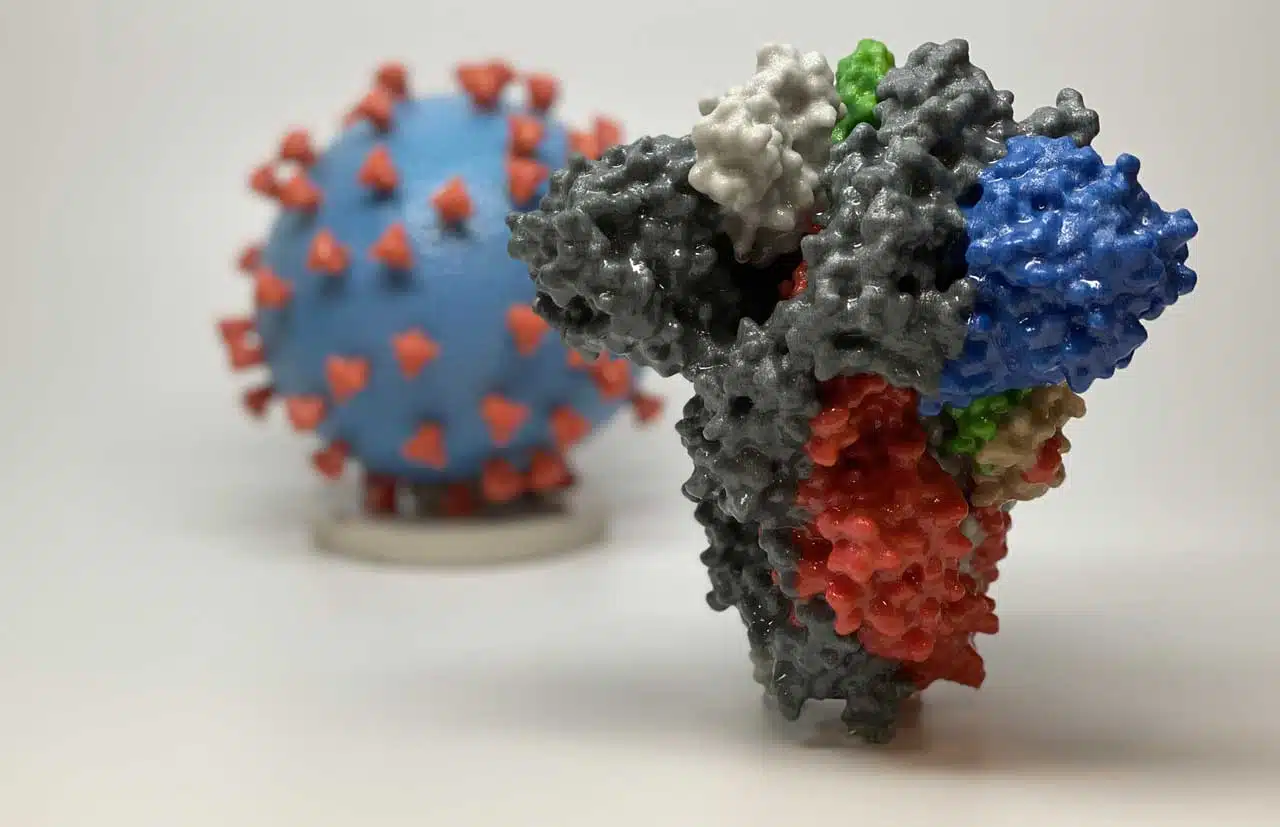
While DARPA rejected the grant on the grounds that the gain-of-function research it proposed would be too risky, the NIAID under the directorship of Dr. Anthony Fauci continued to fund genetic experimentation of coronaviruses by researchers from the Wuhan Institute of Virology via EcoHealth Alliance.
This includes an experiment conducted during a 2018–2019 grant period in which mice genetically engineered to express the human ACE2 cell receptor were infected to determine potential pathogenicity in humans. In comparison to mice infected with the wild-type WIV1 bat coronavirus, mice infected with a chimeric coronavirus engineered to express a spike protein capable of binding to the ACE2 receptor became sicker.
Notably, Baric and Worobey both distanced themselves from the transparent prejudice of the WHO’s ostensible “investigation” into the origin of SARS‑CoV‑2 by joining Dr. Alina Chan and other scientists in signing a letter published in Science on May 14, 2021, calling on the WHO, the US, and other countries to “take hypotheses about both natural and laboratory spillovers seriously until we have sufficient data.”
Titled “Investigate the origins of COVID‑19”, the letter stated that “Theories of accidental release from a lab and zoonotic spillover both remain viable.”
The publication of that letter marked something of an official end to the mainstream media’s disgraceful dismissal of the lab origin hypothesis as a “conspiracy theory”. Facebook’s prohibition of discussion about a lab origin, for example, was lifted shortly thereafter.
To this day, however, the media continue to falsely characterize the evidence as greatly favoring a natural origin for SARS‑CoV‑2.
Dissecting Early Raccoon Dog Claims
In his revisionary Science paper on the earliest known cases of COVID‑19, Worobey acknowledged support from the Bill and Melinda Gates Foundation and, among others, thanked Edward Holmes, Kristian Andersen, and Andrew Rambaut—three of the authors of the “proximal origin” paper—“for assistance and discussions”.
As I mentioned, Worobey’s paper contains numerous false or misleading statements.
“Unfortunately,” Worobey stated, “no live mammal collected at Huanan Market or any other live-animal market in Wuhan has been screened for SARS‑CoV‑2-related viruses.”
This makes it sounds like there were live mammals being sold at the Huanan market and that samples were collected from these mammals, but that Chinese authorities failed to test them for infection.
However, as will be shown, that is untrue on multiple counts.
Worobey also stated that “most early symptomatic cases were linked to Huanan Market—specifically to the western section where raccoon dogs were caged”, which together “provides strong evidence of a live-animal market origin of the pandemic.”
This makes it sound as though it was a known fact that raccoon dogs were being sold at the market at the time of the initial outbreak of COVID‑19, prior to the market being closed and the authorities arriving to take samples.
But that, again, is untrue.
As the WHO reported, no evidence of the sale of live mammals at the Huanan market was found during its investigation, which explains why no live mammals were tested for SARS‑CoV‑2. According to the market manager, none were being sold. A few neighborhood residents who agreed to be interviewed also said that “they had never witnessed any live animals being sold”.
There were ten stalls in the market that sold live animals, the WHO clarified, but not mammals. “The authority of market regulation and supervision”, the report stated, “verified that there was no substantial change in the type of animal business in these 10 stalls in the 12 months before the outbreak.” The market authorities reported that “no illegal trade in wildlife had been found.”
While there was published photographic evidence from 2014 that live mammals, including raccoon dogs, had been sold at the market in the past, the WHO acknowledged, “no verified reports of live mammals being sold around 2019 were found.”
That photographic evidence from 2014 had been submitted to none other than WHO task force member Dr. Peter Daszak, the president of EcoHealth Alliance, by none other than Professor Edward Holmes, coauthor of the “proximal origin” paper, who had taken the photo himself in October of that year while visiting to meet with Professor Zhang Yong-Zhen “and other collaborators at Wuhan”.

Professor Zhang is the scientist whose team first sequenced the whole genome of SARS‑CoV‑2, which was done on January 5, 2020, and was first reported by Edward Holmes on the website Virological on January 10, 2020. The discovery was later reported in the paper “A new coronavirus associated with human respiratory disease in China”, published in Nature on February 3, 2020.
When a coronavirus researcher at the University of North Carolina, Chapel Hill, learned of this sequencing, according to Science, he downloaded the data and “his lab immediately began to try to reverse-engineer a live virus from the sequence”.
The name of that researcher is Dr. Ralph Baric, “who leads one of the few labs in the world”, the Science article added, “that can re-create coronaviruses just from their sequences.”
Returning to the information provided in the WHO report, most of the animal samples collected were from frozen products. Some stray animals, including mammals (cat, dog, mouse, and weasel), were found at the market, and samples from those animals were also collected and tested.
As the WHO report states, “Extensive collection and testing of animal samples in the market and animals in upstream supply farms took place; the SARS‑CoV‑2 PCR test results were all negative.”
Table 3 of the report’s annex lists all of the animals and animal products for sale at the market. Raccoon dogs are absent from the list.
This information from the WHO report falsifies Worobey’s statement that testing was not done for any live mammals collected from the market. Perhaps Worobey miscommunicated, intending his statement to refer only to live mammals being sold at the market, as opposed to strays. But, then, his statement is still at best misleading since, contrary to his accompanying claim, no credible evidence had ever been produced that raccoon dogs (or any other live mammals) were being sold there in late 2019.
The Absence of Evidence for Raccoon Dogs at the Market in Late 2019
In the first paragraph of his revisionary Science paper, Worobey stated, “Despite assertions to the contrary (1), it is now clear that live mammals susceptible to coronavirus, including raccoon dogs (Nyctereutes procyonoides) were sold at Huanan Market and three other live-animal markets in Wuhan before the pandemic (2, 3).” (Emphasis added.)
That statement, however, is a deception. This can be seen by examining Worobey’s cited sources (the reference numbers for which I’ve left intact in the quote above).
His first reference is to the WHO report. Recall that the WHO acknowledged that raccoon dogs had been sold at the market in the past, which acknowledgment was based on Holmes’ photograph from 2014, but that there was no evidence of raccoon dogs in the market at the time of the outbreak.
Thus, the specific allegation that Worobey was making is that the WHO had falsely claimed that no live mammals were being sold at the market at the time of the COVID‑19 outbreak.
His statement thus constituted the counterclaim that it was a proven fact that live mammals were being sold there in late 2019.
But that counterclaim of Worobey’s was a bald-faced lie. The WHO report was absolutely correct to state that no verified evidence to support that claim had ever been produced.
That it is Worobey’s counterclaim that is false is demonstrable by simply checking the sources he cited to support it (references 2 and 3 in the above quote).
The first of those two sources is a paper by Xiao Xiao et al. titled “Animal sales from Wuhan wet markets immediately prior to the COVID‑19 pandemic”, published in Scientific Reports on June 7, 2021.
However, that study does not support Worobey’s claim.
It was a report on live animals being sold at the market sometime between May 2017 and November 2019 in Wuhan’s markets. The relevant evidence presented in that study was a photo of a raccoon dog said to have been taken at the Huanan market. However, neither attribution for the photo nor a capture date was provided.
Consequently, the paper by Xiao et al. is consistent with the WHO report’s acknowledgment that raccoon dogs had previously been sold at the market, but that there was no verified evidence of this occurring at the start of the COVID‑19 outbreak in Wuhan.

The second source cited by Worobey to support his counterclaim is a study published in Cell on August 18, 2021, titled “The origins of SARS‑CoV‑2: A critical review”.
Worobey himself was one of the authors of that study. The lead author was Edward Holmes. Among their coauthors were Angela Rasmussen, Kristian Andersen, Robert Garry, and Andrew Rambaut—all coauthors of the recent Zenodo preprint. Another notable coauthor was Jeremy Farrar.
The “critical review” paper by Holmes et al. similarly claimed, as though a proven fact, that raccoon dogs “were also sold live in Wuhan markets in 2019”.
Further into the paper, the claim is repeated: “During 2019, markets in Wuhan—including the Huanan market—traded many thousands of live wild animals including high-risk species such as civets and raccoon dogs.”
However, the single reference provided for the claim that raccoon dogs were being sold in the market in 2019 is the same paper by Xiao et al. published in Scientific Reports in 2021, which does not show that raccoon dogs were present in the market specifically at the time of the COVID‑19 outbreak.
Thus, while Worobey cited two different sources as though they corroborated each other, in fact, there was just the one primary source that failed to support his claim.
With that deception, the groundwork was being laid for the argument that the COVID‑19 pandemic was the result of a natural spillover event, with raccoon dogs being the new chief suspect in place of the abandoned pangolin hypothesis.
Worobey and his colleagues would subsequently repeat that same false claim in other papers, thus creating an illusion that their claim was supported by publicly available evidence.
That it was their intent to deceive is also evident, as I will further demonstrate.
The Repetition of the False Raccoon Dog Claim
On February 27, 2022, a headline in the New York Times declared, “New Research Points to Wuhan Market as Pandemic Origin”. That article reported on two new preprint studies published at Zenodo.
The first was titled “The Huanan market was the epicenter of SARS‑CoV‑2 emergence”, which had been published on February 26 and, among others, featured lead author Michael Worobey, senior author Kristian Andersen, and coauthors Angela Rasmussen, Robert Garry, Edward Holmes, and Andrew Rambaut.
A peer-reviewed version of that study was published in Science on July 26, 2022, with the title “The Huanan Seafood Wholesale Market in Wuhan was the early epicenter of the COVID-19 pandemic”. The study was funded in part by Anthony Fauci’s NIAID. Numerous authors acknowledged NIH funding, and some also reported funding from the Wellcome Trust.
The second preprint reported by the Times was titled “SARS‑CoV‑2 emergence very likely resulted from at least two zoonotic events”, which was also published at Zenodo on February 26. The lead author was Jonathan Pekar. Among his coauthors were Robert Garry, Edward Holmes, Andrew Rambaut, Kristian Andersen, and Michael Worobey.
A peer-reviewed version of that paper was published in Science on July 26, 2022, with the title “The molecular epidemiology of multiple zoonotic origins of SARS-CoV-2”. That work, too, was funded in part by Anthony Fauci’s NIAID.
In the latter Science paper, Pekar et al. argued that “all of the circumstantial evidence so far points to more than one zoonotic event occurring in Huanan market”.
The basis for this conclusion was the finding that the market was contaminated with “two distinct viral lineages, A and B”, with lineage B, counterintuitively, being the lineage of SARS‑CoV‑2 that was judged more likely to have emerged first.
However, contrary to characterization of this evidence by Pekar et al., the finding of both lineages of SARS‑CoV‑2 in samples collected from the wet market is not inconsistent with the lab origin hypothesis.
Among those who’ve made this observation is Alina Chan, a molecular biologist, scientific advisor at the Broad Institute of MIT and Harvard, and coauthor of Viral: The Search for the Origin of COVID 19. Chan is among those scientists whose research and public stance was instrumental in getting the mainstream media to drop their disgraceful propaganda narrative that the idea of a lab origin is a baseless “conspiracy theory”.
As explained by Chan in an article published on Medium on July 12, 2021, “There were two early lineages of SARS CoV 2: lineage A and lineage B. Importantly, although classified as different lineages, the earliest genomes in each lineage only differ from each other by two letters (nucleotides) out of a total of >29.9K genomic letters. This is a very minute difference that would not, by itself, suggest multiple spillovers of the virus into the human population.” (Emphasis in original.)
In a rebuttal to Pekar at al. published at Zenodo on August 23, 2022, biologist David Bahry emphasized the continued plausibility that the Huanan seafood market “was not the origin of SARS‑CoV‑2, but only an early super-spreader event for lineage B”. There was a single lineage A sample found out of 1,380 samples, of which 73 were positive for the virus, and it was found “after both lineages were already circulating in Wuhan”. Therefore, it “was likely introduced by a human.”
Bahry also pointed out that, while Worobey and his coauthors made much about the fact that most positive samples were clustered around the southwest area of the market, this finding simply reflected ascertainment bias since Chinese researchers would have naturally collected more samples from that area because they already suspected that the outbreak may have originated from animals, and the southwest area of the market is where wildlife stalls were located.
The New York Times article in February 2022 reporting on the two preprints also quoted Dr. Jesse Bloom, a virologist at the Fred Hutchinson Cancer Research Center, who expressed skepticism about the conclusion that there were two separate spillover events at the market. Bloom, like Chan, Worobey, and Baric, was among the scientists who signed the letter in Science calling for a real investigation into the origins of the virus. As the Times reported, Bloom “noted that the Lineage A glove sample from the market was collected some time after the virus had begun spreading in humans, raising the possibility that it had been brought into the market.”
Bloom told the Times, “I am especially unconvinced by the conclusion that there must have necessarily been two different spillovers in the Huanan Seafood Market.”
The other preprint by Worobey et al. and its peer-reviewed counterpart describing the market as the “epicenter” of the outbreak argued that the finding of both lineages coupled with the supposedly proven fact that raccoon dogs were being sold in the market at the time of the COVID‑19 outbreak provided strong evidence for a natural spillover event.
In the peer-reviewed “early epicenter” paper published in Science, Worobey et al. explicitly claimed that raccoon dogs “were sold live at the Huanan market up until at least November 2019 (Table 1 and table S5).” In the same paragraph, they repeat that raccoon dogs “were consistently available for sale throughout the year, including at the Huanan market in November 2019 (Table 1 and table S5).” (Emphasis added.)
But Table 1 of that paper simply claims “Y”, for “yes”, that raccoon dogs were “Observed at Huanan market November 2019”, with the only reference provided to support that claim being the same study by Xiao et al. in Scientific Reports, which, again, only provided evidence for the presence of raccoon dogs in the market sometime between May 2017 and November 2019.
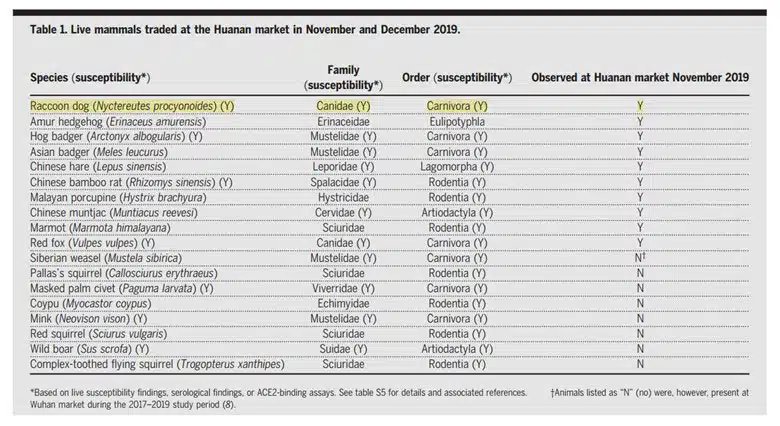
As for Table S5, which was provided in a supplement to the paper, it is simply another table in which it is claimed that the raccoon dog species was “Observed at Huanan market” in October, November, and December of 2019. The only supporting documentation provided is marked by an asterisk on the column for December 2019, which references a note that says, “From photographic evidence from 3 December, 2019 (82).”


The reference number provided is “82”, but scrolling down to the supplement’s endnotes, there is no reference 82 (as shown in the following screenshot from my PDF viewer).

The “82” was an obvious typo, but the fact that the peer reviewers missed this mistake indicates that they didn’t bother to check the source even though this source was cited to support a critical premise of the authors’ argument. This speaks to how the peer-review process can serve to perversely lend legitimacy to false claims.
Setting that aside, the authors clearly intended to cite the last reference, numbered 81, which is a video report from CNN posted on January 19, 2020, to the YouTube channel of CNN anchor Kristie Lu Stout.
Once again, however, the source cited fails to support their claim.
The glaringly propagandistic title of that CNN report was “‘Wuhan SARS’: Tracing the origin of the new virus to China’s wild animal markets”. Here is what the video voiceover says about the images in question (emphasis added):
Images of the market from early December taken by a concerned customer indicate it was apparently selling other live wild animals, including skinned birds, snakes, and raccoon dogs, sparking concern that the virus might have been transmitted from animals to humans. CNN has not independently verified this footage, posted on Chinese social media site Weibo, which has since been deleted by government censors, according to the poster.
Thus, to support their argument for a natural spillover event at the market, Worobey et al. cited an unverified claim as though it were a verified fact.
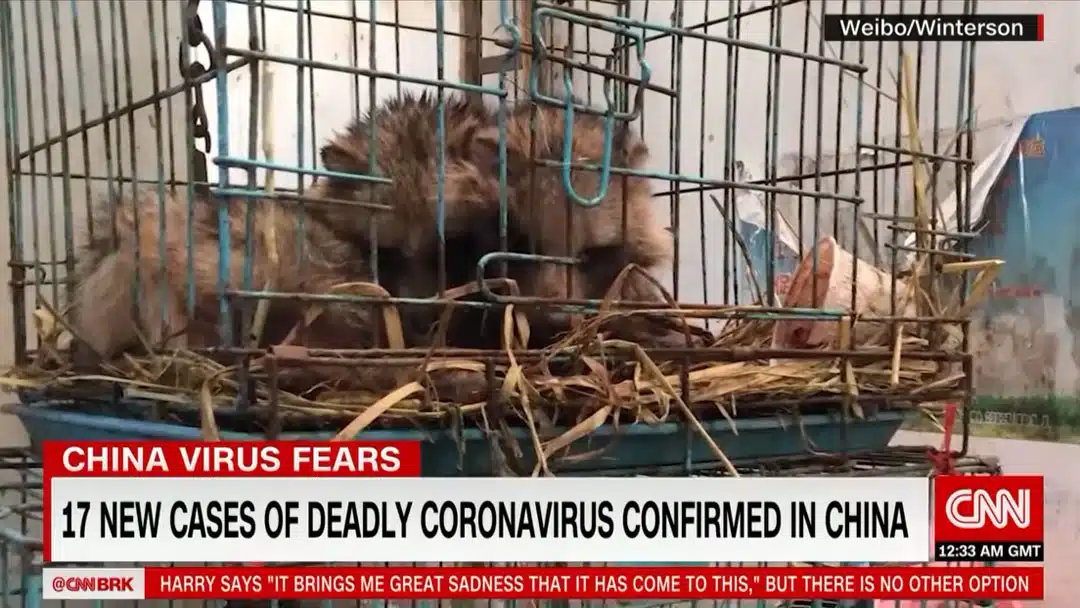
In sum, Worobey and colleagues claimed that it was a proven factthat raccoon dogs were being sold in the Huanan market during November and December of 2019, whereas the only credible source they provided to support that claim merely showed that raccoon dogs were being sold there in 2014 as well as sometime between May 2017 and November 2019.
Recall now that in his Science paper “Dissecting the early COVID-19 cases in Wuhan”, Worobey alleged that the WHO’s claim that there was no verified evidence of live mammals being sold at the time of the outbreak was provably false.
The truth is that it is Worobey’s counterclaim that is false.
That is to say, despite the repeated assertions by Worobey and his colleagues that it was a known fact that raccoon dogs were being sold in the market in late 2019, in fact, the publicly available evidence remained consistent with the information provided by the WHO: there was no verified evidence that raccoon dogs or any other live mammals were being sold in the Huanan market at the time of the COVID‑19 outbreak in Wuhan.
The fact that Worobey et al. were fully cognizant that there was no publicly available evidence to prove their claim is evident from caveats included in the “epicenter” preprint that were omitted from the peer-reviewed version.
In the abstract of the preprint, they similarly stated as though a proven fact that “live mammals, including raccoon dogs, were sold at the market in late 2019”. Further into the paper, they reiterated (emphasis added):
We report that vendors at the Huanan market sold SARS‑CoV‑2-susceptible live mammals, including Asian raccoon dogs . . . , in November and December 2019. Finally, we show that two early lineages of SARS‑CoV‑2 show a clear association with the Huanan market. Collectively, these results provide incontrovertible evidence that there was a clear conduit, via susceptible live mammals, for the zoonotic emergence of SARS‑CoV‑2 at the Huanan market towards the end of 2019.
Notably, the authors’ description of their supposed evidence as “incontrovertible” does not appear in the version of the paper published in Science, and it is clear from admissions omitted from the peer-reviewed version that they knew that their evidence was very much open to question.
Further yet into the preprint, Worobey et al. explicitly acknowledged that the study by Xiao et al. in Scientific Reports about illegal wildlife trade in Chinese markets from May 2017 to November 2019 “did not report sales by specific market or specific month.”
Consequently, they understood perfectly well that this study did not show, as they have elsewhere deceptively claimed, that raccoon dogs were being sold in the Huanan market specifically in November of 2019.
“We build on that work”, the team nevertheless continued, “by breaking down which mammalian species were sold live at the Huanan market during the crucial months of November and December 2019.”
“Based on data collected during the earlier study,” they stated, “we report that . . . raccoon dogs were consistently available throughout the year, including at the Huanan market (Tables 2 and S3).”
They added that raccoon dogs were “noteworthy among the live mammal species traded at the Huanan market in November 2019”.
However, the referenced tables—Table 2 and the supplementary Table S3—both lack supporting documentation for the claim that raccoon dogs were observed at the Huanan market specifically in November; and, as with the peer-reviewed version, for the column claiming that these animals were observed there in December, the only supporting reference provided is the report from CNN that acknowledged that the photos of raccoon dogs allegedly taken in December 2019 remained unverified.
The preprint paper also notes that one of the authors, Chris Newman, was a coauthor of the Scientific Reports study by Xiao et al., so it is possible that the preprint authors had access to evidence not included in that earlier paper showing that raccoon dogs were indeed observed in the Huanan market specifically in November. However, if that were so, it is curious that they omitted that evidence from their paper. They included no photographs, for example, taken specifically taken during November, or any other kind of supporting documentation. Instead, they simply claimed that the animals were there at that time with the evident expectation that the public should just take their word for it.
As for the images of live mammals shown in the CNN report, Worobey et al. acknowledged that they “cannot independently verify their provenance”. They describe the photos as having been “purportedly” taken at the Huanan market on December 3, 2019, by an anonymous source who posted the photos on a Chinese social media site called Sina Weibo and who was “purportedly concerned about the conditions under which live animals were being traded at the market”. (Emphasis added.)
In the supplementary materials, Worobey et al. explained that, although they spoke with the CNN reporter who had spoken with the anonymous source of the photographs and obtained copies of the image files that the source had shared with CNN, the files had been stripped of all metadata. The anonymous source claimed that this was because he had lost the phone used to take the photos and had retrieved them from the phone of a friend to whom he had sent the photos via a messenger app the same day he’d taken them. (Note that even if the files did have metadata showing a capture date of December 3, as claimed, there is software that enables you to edit this data, so it still wouldn’t necessarily make the claim reliable.)
These details were omitted from the peer-reviewed paper in Science. The caveat that the photos were from an anonymous source who purportedly captured them in December, but that this claim remained unverified, was replaced in the peer-reviewed paper with the characterization of the source as absolute proof that raccoon dogs were being sold at the Huanan market at the time of the COVID‑19 outbreak.
It is difficult to ascribe this to anything other than intent to deceive.
Indeed, the conclusion can be reasonably drawn that these earlier claims that it was a proven fact that raccoon dogs were being sold at the Huanan market in late 2019 amounted to an elaborate hoax perpetrated by (or in collaboration with) the very same group of scientists who were “prompted” to “disprove any type of lab theory” by the directors of government agencies that had funded risky gain-of-function experiments with coronaviruses.
And ever since the “proximal origin” paper was first published, the mainstream media have been eating up everything this group of scientists has been dishing out and regurgitating it to the public as though their claims were scientifically demonstrated facts.
Conclusion

The mainstream media would have us believe that the recently released metagenomic data from samples taken from the Huanan seafood market is “the strongest evidence yet” for a natural origin of SARS‑CoV‑2.
However, at present, there remains no evidence that any animals in the market were infected with the virus, much less that an animal transmitted the virus to humans as opposed to the converse.
Additionally, while the media have parroted the claim that it is a proven fact that raccoon dogs were being sold in the market in November and December of 2019, in fact, there remains no conclusive evidence to support that claim.
Well prior to the recent release of metagenomic data by the CCDC, to create the illusion that it was a proven fact that raccoon dogs were present in the Huanan market in late 2019, proponents of the natural origin hypothesis repeated that claim in numerous papers.
Close examination of their cited sources, however, reveals that there were just three primary sources, none of which actually support the claim.
First, there was the photograph taken by Edward Holmes in 2014, which obviously does not prove that raccoon dogs were being sold in the market in late 2019.
Second, there was the study by Xiao et al. in 2021, which only provided evidence to support the conclusion that raccoon dogs were being sold there sometime between May 2017 and November 2019.
Third, there was the CNN report, which Worobey et al. cited as absolute proof of the presence of raccoon dogs in the Huanan market in December 2019 despite knowing perfectly well that those photos remain unverified.
This pattern of citing sources that they knew did not support their claim clearly demonstrates intent to deceive. The claim therefore amounts to an elaborate hoax.
The mainstream media were successfully duped by this hoax into reporting the presence of raccoon dogs in the market at the time of the outbreak as a proven fact despite the absence of credible evidence.
The more recent finding of raccoon dog DNA in a sample collected by CCDC researchers from the same area of the market where Edward Holmes had photographed a raccoon dog in 2014 has been coupled with those earlier false claims to further the illusion.
The genomic data corroborates the photographic evidence, we are being told. But that is a nonsensical argument since, as the WHO rightly reported, there never was any verified evidence of live mammals being sold at the market in 2019.
Moreover, the newly released data only shows that raccoon dog DNA was present in a sample collected from a transport cart parked at a stall in the southwest area of the market.
This is evidence that the cart was used to transport a raccoon dog at some point, and given past evidence, it is reasonable to assume that it was used to carry the animal to or from that particular stall. But what shouldn’t be assumed is that the animal was present in the market when the COVID‑19 outbreak started.
As Viral coauthor Matt Ridley pointed out, we still don’t know this to be a fact “because that DNA could have been left over from months earlier.” As virologist Michael Imperiale similarly told the New York Times, the raccoon dog DNA and the SARS‑CoV‑2 RNA found in the sample “could have been deposited there at potentially widely different times.”
Even if we were to stipulate that raccoon dogs were present in the market during the relevant timeframe, there remains an alternative perspective that is being concealed from mainstream media coverage, which is that if this is the strongest evidence yet for a natural origin, then it only serves to bolster the case for a lab origin.
Indeed, completely absent from the reporting from The Atlantic, the New York Times, and other major media outlets is a discussion of the huge gaps remaining in the zoonotic origin hypothesis and the opposing evidence favoring the conclusion that SARS‑CoV‑2 was created in a lab.
I intend to delve further into that evidence in future articles. For now, though, consider this: Between (a) the circumstantial evidence of raccoon dogs being sold at the same market that is associated with the outbreak of COVID‑19 and (b) the circumstantial evidence of the outbreak occurring just miles from a lab where researchers were conducting risky genetic experimentation on coronaviruses, which seems the more improbable coincidence to you?
[Correction appended, June 6, 2023: As originally published, this article cited an earlier article of mine to support the claim that Dr. Worobey’s argument that Mr. Chen’s symptoms didn’t first appear until December 16 was contradicted by his key cited source, a video report from the Chinese news site The Paper. My article, titled “Was the First Known COVID‑19 Case a Wuhan Market Vendor?”, was published on April 3. I have since learned that I made an error in my analysis and have therefore retracted that conclusion, with full details of my error and the resulting necessary corrections appended to the earlier article. In short, Mr. Chen was admitted to three different hospitals in succession, and I had erred on which hospital Mr. Chen was admitted to on December 22. While a seemingly minor error, it was fatal to my main conclusion that the video report contradicts Mr. Worobey’s purpose for citing it.
This article has been updated to exclude the references to my earlier erroneous conclusion. I have also added information about Dr. Liang Wannian censuring Dr. Worobey for his Science paper. Additional minor and non-substantive edits have been made. I maintain that the evidence remains consistent with an onset date of December 8 as reported by the WHO and that the question of whether the first known COVID‑19 case was Mr. Chen or Ms. Wei is practically irrelevant since everyone agrees neither of these individuals were the first ever infected with SARS‑CoV‑2.
I regret my error and acknowledge and thank TheEngineer2, a member of DRASTIC, a team of researchers dedicated to investigating the origins of SARS‑CoV‑2, for discussing my article and sharing additional sources with me that helped me see how I had erred.]
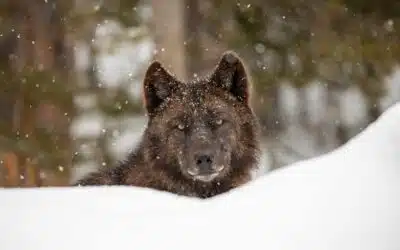
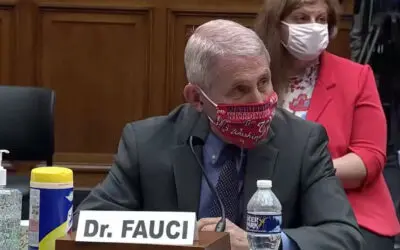

Thank you for this comprehensive and very important analysis.
These erroneous arguments against an iatrogenic origin for SARS-Cov-2 virus closely resemble the arguments proposed against the theory that Koprowski’s experimental oral polio vaccines (OPV) led to the crossover of simian immunodeficiency virus (SIV) from chimpanzees to humans (where it became HIV) in the late 1950’s.
Anyone who has read Edward Hooper’s brilliant book “The River” and his many essays since ( see https://aidsorigins.com) will be very familiar with Michael Worobey, he is one of the ring leader idiots who tried to debunk the OPV theory by publishing studies using computer modeling to time the genetic drift of HIV, and claimed that the proximate beginnings of HIV was well before the experimental OPV vaccines in the early 1900’s. But there was one big problem…HIV is a retrovirus which undergoes mutations much more quickly and not just through point mutations, as Worobey’s modeling assumes.
http://www.aidsorigins.com/the-recent-faria-paper-in-science-more-flimsy-aids-origins-speculations/
And so just like today, Worobey is putting forth incredibly stupid stuff and all it takes is for the media and other “experts” to regurgitate it, and suddenly it becomes the consensus. That’s what happens when you have a public health narrative which must be maintained.
Hi David. Thanks for the positive feedback and links.
Thank you for the work that you are doing to expose the lies. I have attached a link to a podcast on Spotify that is put out by Senator Alex Antic (South Australian Senator) where he interviews Nikolai Petrovsky an immunologist and vaccine developer and clinical researcher. Petrovsky although a world class vaccine developer is scathing in his criticism of health authorities and touches on the impossibility of anything other than a lab leak origin. It is refreshing to hear someone involved in vaccine manufacture being honest and critical of the way the authorities and press have abandoned their obligations to the public to have the right to chose if a vaccine is right for them. Your readers may appreciate his ability to put the science jargon into understandable layman’s terms.
https://open.spotify.com/show/3TGkVz8zTGTUpjEBG4BlvF
I’ve read some of Petrovsky’s insightful stuff on the origin of SARS-CoV-2.
Wow! What a painstaking effort at separating the wheat from the chaff. Quite enlightening.
Glad you found it enlightening!